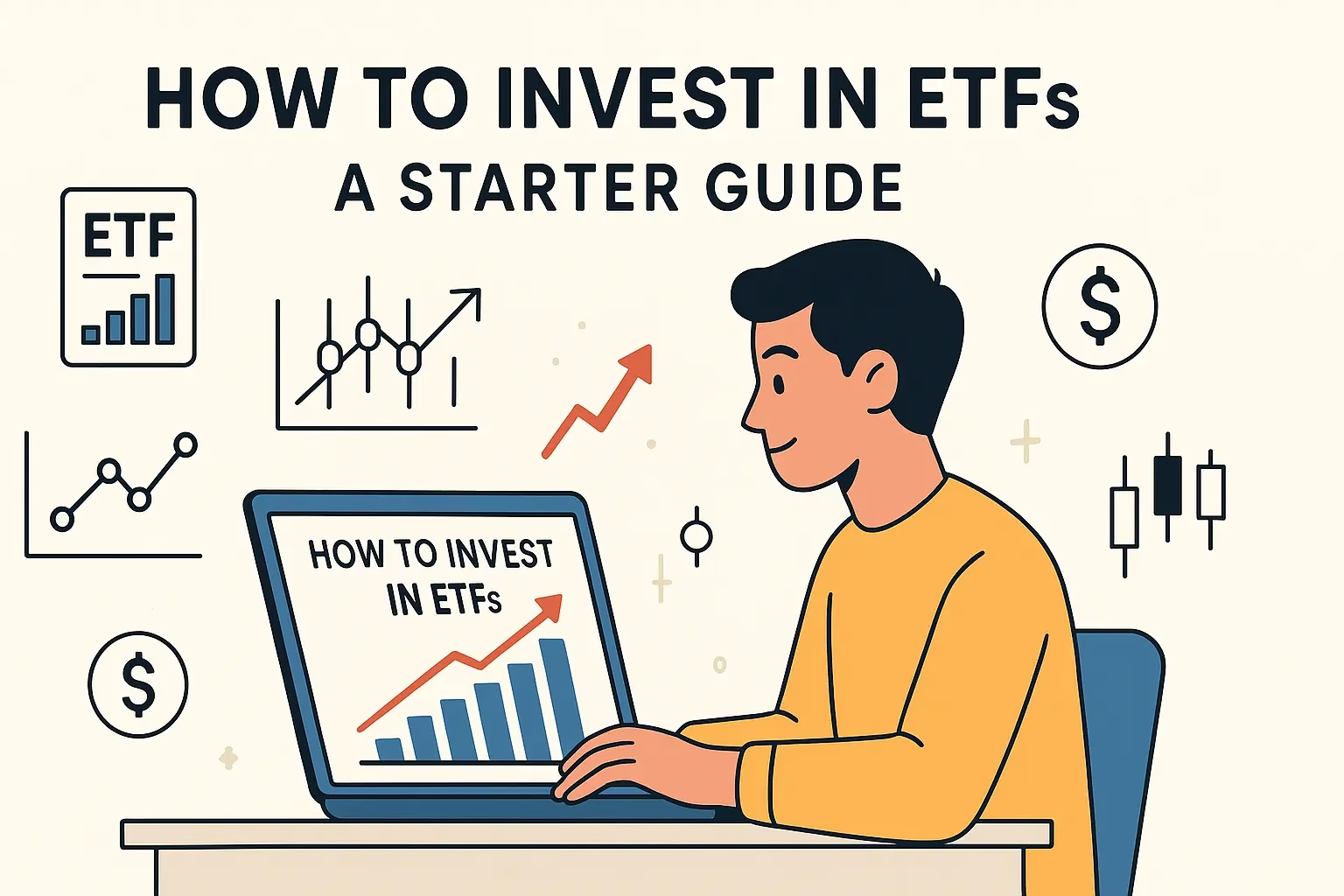Exchange-Traded Funds (ETFs) have become one of the most popular investment options worldwide. They combine the best features of stocks and mutual funds, offering investors a simple, flexible, and affordable way to diversify their portfolios. For those wondering how to invest in ETFs, this guide will break down the process in detail, making it approachable for an ETF investing beginner. From understanding what ETFs are, to choosing the right ones for your goals, to managing them over time, you’ll find everything you need here.
Table of Contents
- What Are ETFs?
- Why Invest in ETFs?
- How Do ETFs Work?
- Types of ETFs Explained
- Steps to Invest in ETFs
- Common ETF Investing Strategies
- ETFs vs. Mutual Funds
- Understanding ETF Costs and Fees
- Risks of Investing in ETFs
- Mistakes to Avoid as a Beginner
- FAQs on ETF Investing
- Conclusion
What Are ETFs?
An Exchange-Traded Fund (ETF) is an investment vehicle that pools money from investors to purchase a collection of assets—such as stocks, bonds, or commodities—that track a specific index or theme. ETFs trade on major stock exchanges, meaning they can be bought and sold during market hours like individual stocks.
For example, an ETF that tracks the S&P 500 index includes shares from all 500 companies in that index. By buying a single ETF share, you gain exposure to a wide range of companies instead of buying each stock individually.
Why Invest in ETFs?
Investors choose ETFs for many reasons. They provide diversification, making them less risky than buying individual stocks. They are also cost-effective, as most ETFs have lower expense ratios than actively managed mutual funds. Here are some key advantages:
- Diversification: A single ETF can include hundreds or even thousands of securities.
- Affordability: Lower management fees keep more of your money invested.
- Flexibility: Buy and sell during market hours, unlike mutual funds that trade once per day.
- Transparency: Most ETFs publish their holdings daily, so you always know what you own.
- Tax Efficiency: ETFs are often more tax-efficient than mutual funds due to their unique structure.
How Do ETFs Work?
ETFs are created and managed through a process involving authorized participants (large financial institutions) and the fund manager. These institutions trade baskets of securities for ETF shares and vice versa, helping maintain the ETF’s market price close to its net asset value (NAV).
Because ETFs trade like stocks, their prices fluctuate throughout the day based on supply and demand. However, mechanisms like arbitrage help keep ETF prices aligned with the underlying assets.
Types of ETFs Explained
Understanding the different kinds of ETFs will help you make informed choices:
- Index ETFs: Track broad indexes such as the S&P 500 or NASDAQ.
- Sector ETFs: Focus on specific industries like technology, healthcare, or energy.
- Bond ETFs: Provide exposure to government, corporate, or municipal bonds.
- International ETFs: Offer access to markets outside your home country.
- Thematic ETFs: Invest in long-term trends like clean energy, artificial intelligence, or robotics.
- Commodity ETFs: Track physical commodities like gold, silver, or oil.
- Dividend ETFs: Focus on stocks that regularly pay dividends, appealing to income-focused investors.
Steps to Invest in ETFs
1. Define Your Goals
Clarify whether you’re investing for retirement, wealth growth, or short-term gains. Long-term investors may prefer broad market ETFs, while income seekers might choose dividend ETFs.
2. Choose a Brokerage Account
Open an account with a reputable online broker. Many now offer commission-free trading on ETFs, which is great for beginners starting small.
3. Research and Compare ETFs
When comparing ETFs, pay attention to:
- Expense Ratio: The lower, the better.
- Liquidity: Higher trading volume means easier buying and selling.
- Tracking Error: Measures how closely the ETF follows its index.
- Holdings: Make sure the ETF aligns with your strategy.
4. Place Your Trade
Decide between a market order (executes immediately at current price) or a limit order (executes only when the price reaches your target).
5. Monitor and Adjust
Keep track of your ETFs and rebalance your portfolio as your financial goals evolve.
Common ETF Investing Strategies
- Buy and Hold: Hold ETFs for years to capture long-term growth.
- Dollar-Cost Averaging: Invest a fixed amount regularly to smooth market ups and downs.
- Core-Satellite Approach: Use broad ETFs for the “core” and specialized ETFs for “satellites.”
- Dividend Reinvestment: Reinvest dividends automatically to compound returns.
ETFs vs. Mutual Funds
| Feature | ETFs | Mutual Funds |
|---|---|---|
| Trading | Throughout the day like stocks | Once daily after market close |
| Fees | Generally lower | Often higher |
| Transparency | Daily disclosure | Quarterly disclosure |
| Tax Efficiency | More tax-efficient | Less tax-efficient |
Understanding ETF Costs and Fees
While ETFs are low-cost compared to many other investments, it’s essential to understand their fees:
- Expense Ratio: Annual fee charged as a percentage of assets.
- Bid-Ask Spread: The difference between the buying and selling price of an ETF.
- Brokerage Fees: Some brokers charge for trading, though many now offer commission-free ETFs.
Risks of Investing in ETFs
Like any investment, ETFs carry risks:
- Market Risk: ETFs lose value if the underlying assets decline.
- Liquidity Risk: Some niche ETFs may have low trading volume.
- Tracking Error: The ETF may not perfectly mirror its benchmark index.
- Concentration Risk: Sector or thematic ETFs may be less diversified.
Mistakes to Avoid as a Beginner
- Overdiversifying: Owning too many ETFs can lead to overlapping holdings.
- Ignoring Costs: Even low expense ratios add up over decades.
- Chasing Trends: Buying “hot” ETFs without understanding their risks.
- Neglecting Rebalancing: Letting your portfolio drift away from your target allocation.
FAQs on ETF Investing
1. Can I lose money in ETFs?
Yes, ETFs are subject to market risk. While they are diversified, they can lose value when the broader market declines.
2. Do I need a lot of money to start?
No, you can start with as little as the cost of one share. Many brokers also allow fractional share investing.
3. Are ETFs better than stocks for beginners?
ETFs are generally safer for beginners because they spread risk across many assets instead of relying on the performance of a single stock.
4. Can I hold ETFs in a retirement account?
Yes, ETFs can be held in retirement accounts like IRAs and 401(k)s, making them a great long-term investment choice.
Conclusion
Learning how to invest in ETFs is one of the smartest steps an ETF investing beginner can take. ETFs offer simplicity, diversification, cost savings, and flexibility—qualities that make them suitable for nearly any investor. By setting clear goals, choosing the right funds, understanding costs, and avoiding common mistakes, you can start building a resilient portfolio that grows with you over time.
Whether you’re just starting out or refining your investment strategy, ETFs provide a powerful foundation for long-term wealth creation. The sooner you begin, the more time your investments will have to compound. Take the first step today—open a brokerage account and start exploring ETFs that align with your financial future.


